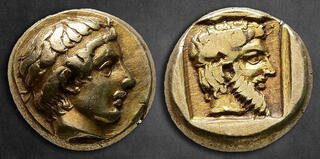| Savoca Numismatik GmbH & Co. KG > Online Auction 198 | Silver | Auction date: 25 February 2024 |
| Lot number: 61 Price realized: 1,100 EUR (Approx. 1,189 USD) Note: Prices do not include buyer's fees. | Show similar lots on CoinArchives Find similar lots in upcoming auctions on |
| Lot description: Lesbos. Mytilene circa 454-428 BC. Sixth Stater or Hekte EL 11 mm, 2,59 g Young male head right, wearing tainia / Wreathed male head right, wearing long beard, in incuse square. Good Very Fine Bodenstedt 52; HGC 6, 978. From a southern German private collection; Ex CNG Auction 105, Lot 265. Early electrum coinage introduced several denominations that revolutionized commerce in the ancient world. Among these, the stater served as the primary unit of currency, boasting intricate designs reflective of the issuing city or kingdom's wealth. Its weight, typically around 14 grams, established a standardized value for transactions. The hecte, or half-stater, emerged as a practical subdivision, facilitating exchanges of lesser value. Despite its smaller size, hectes maintained the artistic standards of the coinage, featuring detailed engravings and symbols. In addition to these primary denominations, fractions such as the trite (one-third of a stater) and the sixth-stater (one-sixth of a stater) catered to a broader range of economic transactions. These fractions allowed for greater flexibility in commerce, accommodating transactions of varying values. However, it's important to note that standardization was not universal across regions and periods. Variations in weight and purity necessitated the use of scales and balances to verify coin values during transactions. Despite these challenges, the introduction of these denominations represented a significant leap forward in monetary systems, providing a more efficient means of exchange compared to earlier bartering systems and laying the groundwork for the development of more sophisticated monetary systems in subsequent centuries. Starting price: 200 EUR |  |


